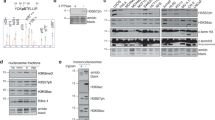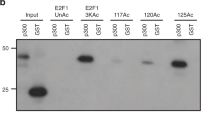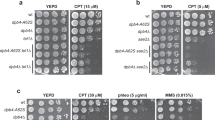Abstract
Histone H2AX is rapidly phosphorylated in the chromatin micro-environment surrounding a DNA double-strand break (DSB). Although H2AX deficiency is not detrimental to life, H2AX is required for the accumulation of numerous essential proteins into irradiation induced foci (IRIF). However, the relationship between IRIF formation, H2AX phosphorylation (γ-H2AX) and the detection of DNA damage is unclear. Here, we show that the migration of repair and signalling proteins to DSBs is not abrogated in H2AX−/− cells, or in H2AX-deficient cells that have been reconstituted with H2AX mutants that eliminate phosphorylation. Despite their initial recruitment to DSBs, numerous factors, including Nbs1, 53BP1 and Brca1, subsequently fail to form IRIF. We propose that γ-H2AX does not constitute the primary signal required for the redistribution of repair complexes to damaged chromatin, but may function to concentrate proteins in the vicinity of DNA lesions. The differential requirements for factor recruitment to DSBs and sequestration into IRIF may explain why essential regulatory pathways controlling the ability of cells to respond to DNA damage are not abolished in the absence of H2AX.
This is a preview of subscription content, access via your institution
Access options
Subscribe to this journal
Receive 12 print issues and online access
$209.00 per year
only $17.42 per issue
Buy this article
- Purchase on Springer Link
- Instant access to full article PDF
Prices may be subject to local taxes which are calculated during checkout



Similar content being viewed by others
References
Rouse, J. & Jackson, S.P. Interfaces between the detection, signaling, and repair of DNA damage. Science 297, 547–551 (2002).
Nelms, B.E., Maser, R.S., MacKay, J.F., Lagally, M.G. & Petrini, J.H. In situ visualization of DNA double-strand break repair in human fibroblasts. Science 280, 590–592 (1998).
Paull, T.T. et al. A critical role for histone H2AX in recruitment of repair factors to nuclear foci after DNA damage. Curr. Biol. 10, 886–895 (2000).
Bassing, C.H. et al. Increased ionizing radiation sensitivity and genomic instability in the absence of histone H2AX. Proc. Natl Acad. Sci. USA 99, 8173–8178 (2002).
Celeste, A. et al. Genomic instability in mice lacking histone H2AX. Science 296, 922–927 (2002).
Maser, R.S., Monsen, K.J., Nelms, B.E. & Petrini, J.H. hMre11 and hRad50 nuclear foci are induced during the normal cellular response to DNA double-strand breaks. Mol. Cell Biol. 17, 6087–6096 (1997).
Kobayashi, J. et al. NBS1 Localizes to γ-H2AX Foci through Interaction with the FHA/BRCT Domain. Curr. Biol. 12, 1846–1851 (2002).
Rappold, I., Iwabuchi, K., Date, T. & Chen, J. Tumor suppressor p53 binding protein 1 (53BP1) is involved in DNA damage-signaling pathways. J. Cell Biol. 153, 613–620 (2001).
Tauchi, H., Matsuura, S., Kobayashi, J., Sakamoto, S. & Komatsu, K. Nijmegen breakage syndrome gene, NBS1, and molecular links to factors for genome stability. Oncogene 21, 8967–8980 (2002).
Rogakou, E.P., Boon, C., Redon, C. & Bonner, W.M. Megabase chromatin domains involved in DNA double-strand breaks in vivo. J. Cell Biol. 146, 905–916 (1999).
Maser, R.S. et al. Mre11 complex and DNA replication: linkage to E2F and sites of DNA synthesis. Mol. Cell Biol. 21, 6006–6016 (2001).
Mirzoeva, O.K. & Petrini, J.H. DNA damage-dependent nuclear dynamics of the mre11 complex. Mol. Cell Biol. 21, 281–288 (2001).
Schultz, L.B., Chehab, N.H., Malikzay, A. & Halazonetis, T.D. p53 binding protein 1 (53BP1) is an early participant in the cellular response to DNA double-strand breaks. J. Cell Biol. 151, 1381–1390 (2000).
Downs, J.A., Lowndes, N.F. & Jackson, S.P. A role for Saccharomyces cerevisiae histone H2A in DNA repair. Nature 408, 1001–1004 (2000).
Burma, S., Chen, B.P., Murphy, M., Kurimasa, A. & Chen, D.J. ATM phosphorylates histone H2AX in response to DNA double-strand breaks. J. Biol. Chem. 276, 42462–42467 (2001).
Wang, J.Y. Cancer: New link in a web of human genes. Nature 405, 404–405 (2000).
Mirzoeva, O.K. & Petrini, J.H. DNA replication-dependent nuclear dynamics of the mre11 complex. Mol. Cancer Res. 1, 207–218 (2003).
Jenuwein, T. & Allis, C.D. Translating the histone code. Science 293, 1074–1080 (2001).
Rogakou, E.P., Pilch, D.R., Orr, A.H., Ivanova, V.S. & Bonner, W.M. DNA double-stranded breaks induce histone H2AX phosphorylation on serine 139. J. Biol. Chem. 273, 5858–5868 (1998).
Zou, L., Cortez, D. & Elledge, S.J. Regulation of ATR substrate selection by Rad17-dependent loading of Rad9 complexes onto chromatin. Genes Dev. 16, 198–208 (2002).
Andegeko, Y. et al. Nuclear retention of ATM at sites of DNA double strand breaks. J. Biol. Chem. 276, 38224–38230 (2001).
Paull, T.T. & Gellert, M. The 3′ to 5′ exonuclease activity of Mre 11 facilitates repair of DNA double-strand breaks. Mol. Cell 1, 969–979 (1998).
Paull, T.T., Cortez, D., Bowers, B., Elledge, S.J. & Gellert, M. Direct DNA binding by Brca1. Proc. Natl Acad. Sci. USA 98, 6086–6091 (2001).
van Gent, D.C., Hoeijmakers, J.H. & Kanaar, R. Chromosomal stability and the DNA double-stranded break connection. Nature Rev. Genet. 2, 196–206 (2001).
Khanna, K.K. & Jackson, S.P. DNA double-strand breaks: signaling, repair and the cancer connection. Nature Genet. 27, 247–254 (2001).
Fernandez-Capetillo, O. et al. DNA damage-induced G2–M checkpoint activation by histone H2AX and 53BP1. Nature Cell Biol. 4, 993–997 (2002).
Yagi, H. et al. Regulation of the mouse histone H2A.X gene promoter by the transcription factor E2F and CCAAT binding protein. J. Biol. Chem. 270, 18759–18765 (1995).
Acknowledgements
We thank M. Gellert, A. Singer and R. Hodes for critical comments on the manuscript. We also thank D. Sackett for assistance, Y. Pommier and P. Leder for kindly providing the ATM-deficient cells, S. Ganesan and J. Chen for kindly providing Brca1 and 53BP1 antibodies. In addition, we also thank R. Schroff and M. Lichten for sharing unpublished data.
Author information
Authors and Affiliations
Corresponding author
Ethics declarations
Competing interests
The authors declare no competing financial interests.
Supplementary information
Figure S1. IR-induced redistribution of Nbs1 from PCNA clusters is H2AX independent.
Figure S2. Typing of reconstituted P53-/-H2AX-/- cells by 2-D gel analysis of histones. (PDF 1297 kb)
Rights and permissions
About this article
Cite this article
Celeste, A., Fernandez-Capetillo, O., Kruhlak, M. et al. Histone H2AX phosphorylation is dispensable for the initial recognition of DNA breaks. Nat Cell Biol 5, 675–679 (2003). https://doi.org/10.1038/ncb1004
Received:
Accepted:
Published:
Issue Date:
DOI: https://doi.org/10.1038/ncb1004
This article is cited by
-
AURKB promotes bladder cancer progression by deregulating the p53 DNA damage response pathway via MAD2L2
Journal of Translational Medicine (2024)
-
Trypanosoma cruzi infection induces DNA double-strand breaks and activates DNA damage response pathway in host epithelial cells
Scientific Reports (2024)
-
H2A.X promotes endosperm-specific DNA methylation in Arabidopsis thaliana
BMC Plant Biology (2023)
-
The inverse association between DNA gaps and HbA1c levels in type 2 diabetes mellitus
Scientific Reports (2023)
-
Sub-lethal doses of chemotherapeutic agents induce senescence in T cells and upregulation of PD-1 expression
Clinical and Experimental Medicine (2023)



